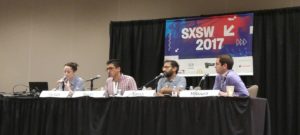According to the panelists hosting (10)99 Problems and W-2s Ain’t One, the so-called gig economy has picked up significant steam within the last few years.
It’s simple really, Americans are frequently working part-time, whether it’s traditional freelancing jobs like photography, or the newly created ride sharing economy.

Colleen Poynton said that Americans working part-time jobs has increased from 30 percent in 2005, to 40 percent in 2010. The majority of the audience raised their hands when Poynton asked if they had worked part-time jobs or as freelancers.
As you can imagine, this figure has only risen in the recent years, especially with the increase of mobile ride sharing. Clearly, this shift in employment is one of the largest economic trends in the last decade.
Sheel Mohnot, an investor in startups himself, said that this environment of people willing to work as freelancers or independent contractors has lead to entrepreneurs and innovators providing new opportunities for these workers. Naturally, this means more and more workers are receiving 1099 forms rather than W-2 forms.
One of the biggest benefits to these workers is the flexibility of the work. Hours are often adaptable to individual needs.
Unfortunately, all of the panelists echoed that this type of freelance work may also come at a cost.
Businesses like using freelancers and independent contractors to avoid having to pay for benefits, like healthcare and retirement funds.
These workers are also at risk of losing their jobs to automation, as tech companies continue to make strides in self-driving cars. Poynton in particular was concerned about how future tech developments could stall employment.
Additionally, the panelists stressed how complex the tax system is regarding freelance work. Government regulations treat freelancers like small businesses, even though the workers see themselves more as employees.

